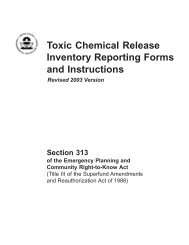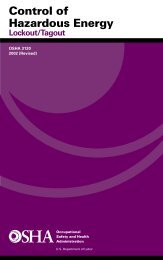Preventing Mold-Related Problems in the Indoor Workplace - Seton ...
Preventing Mold-Related Problems in the Indoor Workplace - Seton ...
Preventing Mold-Related Problems in the Indoor Workplace - Seton ...
You also want an ePaper? Increase the reach of your titles
YUMPU automatically turns print PDFs into web optimized ePapers that Google loves.
Information on <strong>in</strong>door mold exposures is constantly chang<strong>in</strong>g.<br />
As new and critical <strong>in</strong>formation develops, build<strong>in</strong>g professionals<br />
and occupants who access <strong>the</strong> <strong>in</strong>formation will be able to <strong>in</strong>corporate<br />
<strong>the</strong> <strong>in</strong>formation <strong>in</strong>to successful resolution of any exist<strong>in</strong>g<br />
build<strong>in</strong>g mold problems (7).<br />
Build<strong>in</strong>g-related illnesses (BRIs)<br />
The term build<strong>in</strong>g-related illness (BRI) is used to describe<br />
illnesses that are characterized by objective cl<strong>in</strong>ical f<strong>in</strong>d<strong>in</strong>gs related<br />
to specific exposures <strong>in</strong> <strong>the</strong> <strong>in</strong>door environment. Build<strong>in</strong>g-related<br />
illnesses (BRIs) are diagnosed by evaluation of signs and symptoms<br />
by physicians or o<strong>the</strong>r licensed health care professionals. <strong>Mold</strong>related<br />
BRIs result from mold contam<strong>in</strong>ation that has occurred <strong>in</strong><br />
build<strong>in</strong>gs under specific conditions. All BRIs are preventable by<br />
elim<strong>in</strong>at<strong>in</strong>g and controll<strong>in</strong>g <strong>the</strong> conditions that can lead to <strong>the</strong><br />
harmful exposures.<br />
How Sick Build<strong>in</strong>g Syndrome (SBS) differs from BRI<br />
Terms such as Sick Build<strong>in</strong>g Syndrome (SBS) have been used<br />
to describe situations <strong>in</strong> which build<strong>in</strong>g occupants experience a<br />
variety of symptoms that, unlike BRIs, appear to be l<strong>in</strong>ked to time<br />
spent <strong>in</strong> a build<strong>in</strong>g, but no specific illness or cause can be identified<br />
(8). Symptoms often disappear after occupants leave <strong>the</strong> build<strong>in</strong>g<br />
(9).<br />
BRIs l<strong>in</strong>ked to mold exposure<br />
The health effects of concern from exposure to mold contam<strong>in</strong>ation<br />
<strong>in</strong> an <strong>in</strong>door environment can be common allergic BRIs such as<br />
allergic rh<strong>in</strong>itis, allergic asthma, and hypersensitivity pneumonitis<br />
(also called extr<strong>in</strong>sic allergic alveolitis) (10, 11), and <strong>in</strong>fections such<br />
as histoplasmosis and cryptococcosis. Mycotox<strong>in</strong>s can also produce<br />
tox<strong>in</strong>-mediated adverse health effects. The follow<strong>in</strong>g discussions of<br />
selected mold-related BRIs are not <strong>in</strong>tended to be comprehensive,<br />
i.e., <strong>the</strong> descriptions do not <strong>in</strong>clude diagnostic tests or medical<br />
treatments. Ra<strong>the</strong>r, <strong>the</strong> discussions are <strong>in</strong>formational and focused<br />
on common BRIs.<br />
8
















